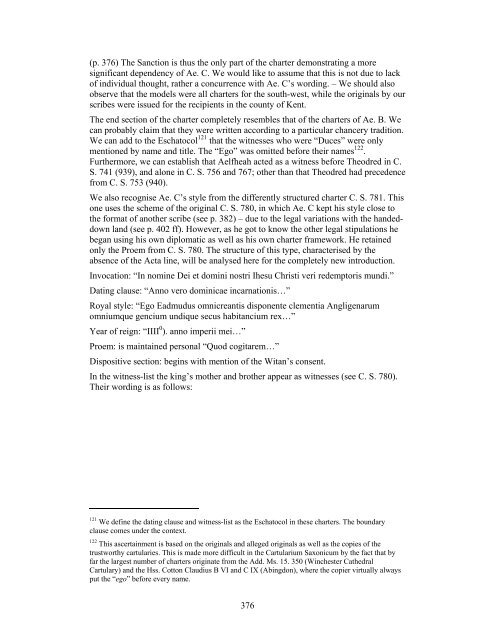Provisional Drogereit pdf
Provisional Drogereit pdf
Provisional Drogereit pdf
Create successful ePaper yourself
Turn your PDF publications into a flip-book with our unique Google optimized e-Paper software.
(p. 376) The Sanction is thus the only part of the charter demonstrating a more<br />
significant dependency of Ae. C. We would like to assume that this is not due to lack<br />
of individual thought, rather a concurrence with Ae. C’s wording. – We should also<br />
observe that the models were all charters for the south-west, while the originals by our<br />
scribes were issued for the recipients in the county of Kent.<br />
The end section of the charter completely resembles that of the charters of Ae. B. We<br />
can probably claim that they were written according to a particular chancery tradition.<br />
We can add to the Eschatocol 121 that the witnesses who were “Duces” were only<br />
mentioned by name and title. The “Ego” was omitted before their names 122 .<br />
Furthermore, we can establish that Aelfheah acted as a witness before Theodred in C.<br />
S. 741 (939), and alone in C. S. 756 and 767; other than that Theodred had precedence<br />
from C. S. 753 (940).<br />
We also recognise Ae. C’s style from the differently structured charter C. S. 781. This<br />
one uses the scheme of the original C. S. 780, in which Ae. C kept his style close to<br />
the format of another scribe (see p. 382) – due to the legal variations with the handeddown<br />
land (see p. 402 ff). However, as he got to know the other legal stipulations he<br />
began using his own diplomatic as well as his own charter framework. He retained<br />
only the Proem from C. S. 780. The structure of this type, characterised by the<br />
absence of the Acta line, will be analysed here for the completely new introduction.<br />
Invocation: “In nomine Dei et domini nostri Ihesu Christi veri redemptoris mundi.”<br />
Dating clause: “Anno vero dominicae incarnationis…”<br />
Royal style: “Ego Eadmudus omnicreantis disponente clementia Angligenarum<br />
omniumque gencium undique secus habitancium rex…”<br />
Year of reign: “IIII 0 ). anno imperii mei…”<br />
Proem: is maintained personal “Quod cogitarem…”<br />
Dispositive section: begins with mention of the Witan’s consent.<br />
In the witness-list the king’s mother and brother appear as witnesses (see C. S. 780).<br />
Their wording is as follows:<br />
121<br />
We define the dating clause and witness-list as the Eschatocol in these charters. The boundary<br />
clause comes under the context.<br />
122 This ascertainment is based on the originals and alleged originals as well as the copies of the<br />
trustworthy cartularies. This is made more difficult in the Cartularium Saxonicum by the fact that by<br />
far the largest number of charters originate from the Add. Ms. 15. 350 (Winchester Cathedral<br />
Cartulary) and the Hss. Cotton Claudius B VI and C IX (Abingdon), where the copier virtually always<br />
put the “ego” before every name.<br />
376
















